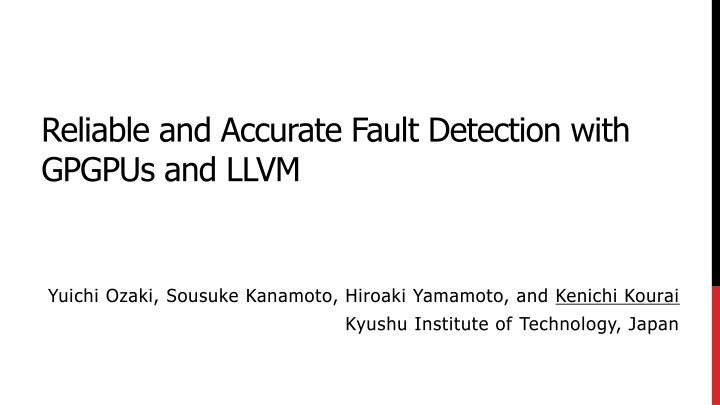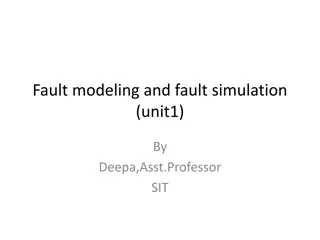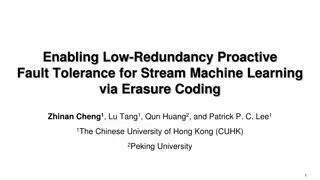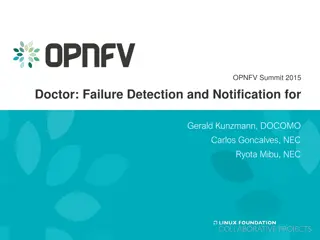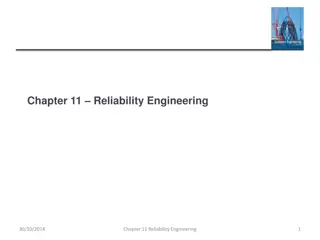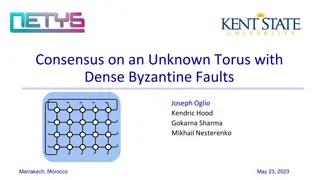Reliable and Accurate Fault Detection with GPGPUs
Fault detection in cloud systems is crucial to prevent system failures. This study explores reliable fault detection using GPGPUs and LLVM, enhancing accuracy and root cause identification. The approach, GPUSentinel, leverages dedicated GPUs for white-box monitoring, minimizing system faults propagation and enhancing system resource fault detection. The implementation involves monitoring OS data from GPUs, mapping main memory, and utilizing CUDA for efficient fault detection.
Download Presentation

Please find below an Image/Link to download the presentation.
The content on the website is provided AS IS for your information and personal use only. It may not be sold, licensed, or shared on other websites without obtaining consent from the author.If you encounter any issues during the download, it is possible that the publisher has removed the file from their server.
You are allowed to download the files provided on this website for personal or commercial use, subject to the condition that they are used lawfully. All files are the property of their respective owners.
The content on the website is provided AS IS for your information and personal use only. It may not be sold, licensed, or shared on other websites without obtaining consent from the author.
E N D
Presentation Transcript
Reliable and Accurate Fault Detection with GPGPUs and LLVM Yuichi Ozaki, Sousuke Kanamoto, Hiroaki Yamamoto, and Kenichi Kourai Kyushu Institute of Technology, Japan
2 Fault Detection Systems in clouds are getting larger and more complex It is difficult to avoid system faults One system fault can result in a system failure System faults should be detected reliably and accurately Fault detectors have to always detect system faults Detailed information is necessary to identify root causes fault fault detector
3 Black-box Monitoring Run fault detectors in remote hosts E.g., heartbeat monitoring of hosts and services System faults probably occurs if there is no response Cannot achieve accurate fault detection Fault detectors cannot identify fault types It is difficult to obtain detailed information heartbeat target system fault detector remote host target host
4 White-box Monitoring Run fault detectors inside target systems Can obtain more detailed information Easily identify fault types and root causes in the OS Cannot achieve reliable fault detection Fault detectors may not work correctly once a system fault occurs System faults can stop the OS or terminate detector processes target system fault detector OS target host
5 Our Approach: GPUSentinel Achieve more reliable white-box monitoring with GPUs Run fault detectors in a dedicated GPU System faults are not easily propagated to fault detectors in a GPU Monitor OS data in main memory to detect system faults Can detect system faults that run out of system resources E.g., out-of-memory and deadlocks with spinlocks target system fault detector monitor OS target host memory CPU GPU
6 Monitoring OS data from GPUs Map the entire main memory onto a GPU with CUDA Use a special device provided by the modified Linux kernel Prevent all the memory pages from becoming in use Access OS data in main memory from a GPU with DMA Translate the virtual address of OS data into a GPU address Transform programs to perform this address translation with LLVM GPU memory address translation LLVM DMA detector program fault detector main memory OS data CPU GPU
7 Easy Development of Fault Detectors Develop fault detectors like OS kernel modules Reuse the source code of the Linux kernel E.g., Data structures, global variables, inline functions, and macros Write fault detectors in C CUDA programs are usually written in C++ Modify clang so that CUDA programs are compiled as C bit fat llc / ptxax / fatbinary bit clang opt code binary code CUDA program fault detector clang ++ object file
8 Metrics for Detecting System Hangs Obtain 8 metrics by analyzing OS data in a GPU Metrics on CPUs CPU utilization for the kernel (sys) and processes (usr) # of timer interupts (int) Metrics on CPU scheduling # of context switches (cs) and uninterruptible processes (sleep) Metrics on memory Free memory (free) and # of swap-outs (swp) Metric on kernel panic Spinlock acquired on panic (panic) kernel_cpustat jiffies rq task_struct vm_stat fault detector panic_lock
9 Examples of Fault Detectors Provide 7 fault detectors by combining the 8 metrics Detect infinite loops with Interrupts disabled (F1) Interrupts/preemption enabled (F2) Interrupts enabled but preemption disabled (F3) Detect indefinite waits due to Resources not released (F4) Sleep while holding a lock (F5) Abnormal resource consumption (F6) Detect a kernel panic (F7) CPU scheduling memory panic sys usr int cs sleep free swp F1 F2 F3 F4 F5 F6 F7
10 Experiments We conducted several experiments using GPUSentinel Confirmed that GPU-based fault detectors could detect system faults Compared with OS-based fault detectors Examined the performance impact of GPUSentinel target host Intel Xeon E5-1603 v4 DDR4 8 GB NVIDIA Quadro M4000 Linux 4.4.64 8.0.61 CPU memory GPU OS CUDA
11 Detectability of System Faults We injected system faults into the Linux kernel Developed kernel modules that caused faults F1-F7 GPUSentinel could detect all the faults in 1 sec at most Identified the thread names of the root causes for F1-F3 and F5 We reproduced the actual fault reported in Bugzilla Caused a deadlock by accessing a directory in XFS GPUSentinel could detect this fault after 32 processes accessed it infinite loops F2 (no interrupt /preemption) indefinite waits F5 (lock holder) panic F7 F1 F3 F4 F6 (no interrupt) (no preemption) (deadlock) (out-of-memory)
12 Comparison with OS-level Fault Detectors We compared GPU-based detectors with OS-level ones Monitored the same metrics inside the OS kernel Driven by timer interrupts OS-level detectors could not detect F1 and F7 We needed to modify the kernel to develop such detectors Necessary kernel variables were not exported to kernel modules Not easy to develop new fault detectors F2 F3 F4 F5 F6 F7 F1 (panic) (no interrupt)
13 Performance Overhead A fault detector continuously performed DMA in a GPU The STREAM benchmark accessed main memory on CPUs The fault detector degraded STREAM performance by 33% STREAM degraded detector performance by 20% The overhead was negligible in the realistic number of GPU threads 20 70 STREAM throughput detector throughput 60 -33% -20% 15 50 (MB/s) (GB/s) 40 10 30 w/o STREAM w/ STREAM Copy Add Scale Triad 20 5 10 0 0 0 256 512 768 1024 0 256 512 768 1024 GPU threads GPU threads
14 Conclusion We proposed GPUSentinel for reliable and accurate fault detection Monitor OS data in main memory from GPUs Provide a development framework using LLVM Developed 7 GPU-level fault detectors Could detect injected system faults successfully Future work Support the detection of various types of system faults Detect faults in the hypervisors of virtualized systems
